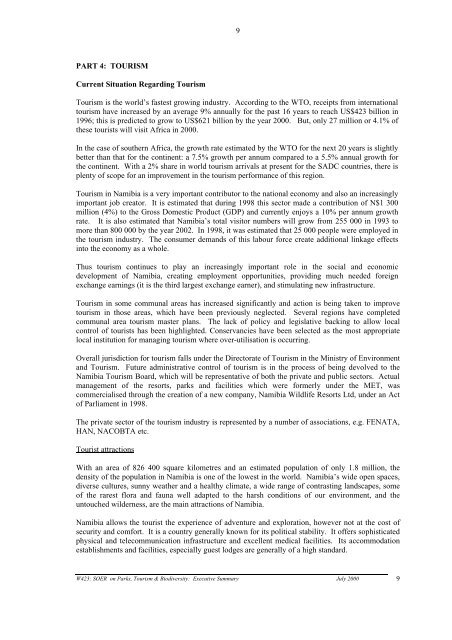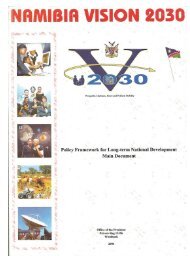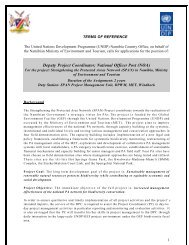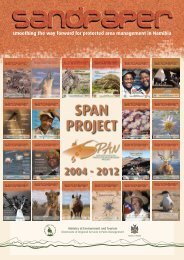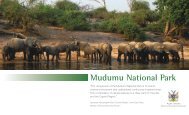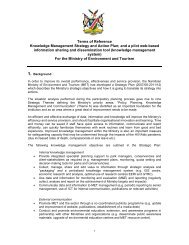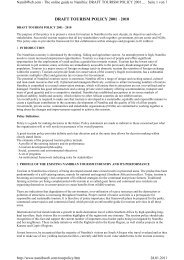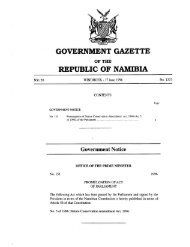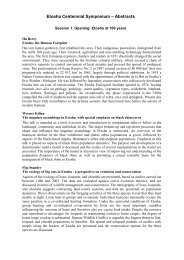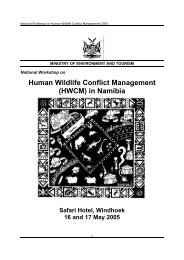EXECUTIVE SUMMARY - Ministry of Environment and Tourism
EXECUTIVE SUMMARY - Ministry of Environment and Tourism
EXECUTIVE SUMMARY - Ministry of Environment and Tourism
You also want an ePaper? Increase the reach of your titles
YUMPU automatically turns print PDFs into web optimized ePapers that Google loves.
9<br />
PART 4: TOURISM<br />
Current Situation Regarding <strong>Tourism</strong><br />
<strong>Tourism</strong> is the world’s fastest growing industry. According to the WTO, receipts from international<br />
tourism have increased by an average 9% annually for the past 16 years to reach US$423 billion in<br />
1996; this is predicted to grow to US$621 billion by the year 2000. But, only 27 million or 4.1% <strong>of</strong><br />
these tourists will visit Africa in 2000.<br />
In the case <strong>of</strong> southern Africa, the growth rate estimated by the WTO for the next 20 years is slightly<br />
better than that for the continent: a 7.5% growth per annum compared to a 5.5% annual growth for<br />
the continent. With a 2% share in world tourism arrivals at present for the SADC countries, there is<br />
plenty <strong>of</strong> scope for an improvement in the tourism performance <strong>of</strong> this region.<br />
<strong>Tourism</strong> in Namibia is a very important contributor to the national economy <strong>and</strong> also an increasingly<br />
important job creator. It is estimated that during 1998 this sector made a contribution <strong>of</strong> N$1 300<br />
million (4%) to the Gross Domestic Product (GDP) <strong>and</strong> currently enjoys a 10% per annum growth<br />
rate. It is also estimated that Namibia’s total visitor numbers will grow from 255 000 in 1993 to<br />
more than 800 000 by the year 2002. In 1998, it was estimated that 25 000 people were employed in<br />
the tourism industry. The consumer dem<strong>and</strong>s <strong>of</strong> this labour force create additional linkage effects<br />
into the economy as a whole.<br />
Thus tourism continues to play an increasingly important role in the social <strong>and</strong> economic<br />
development <strong>of</strong> Namibia, creating employment opportunities, providing much needed foreign<br />
exchange earnings (it is the third largest exchange earner), <strong>and</strong> stimulating new infrastructure.<br />
<strong>Tourism</strong> in some communal areas has increased significantly <strong>and</strong> action is being taken to improve<br />
tourism in those areas, which have been previously neglected. Several regions have completed<br />
communal area tourism master plans. The lack <strong>of</strong> policy <strong>and</strong> legislative backing to allow local<br />
control <strong>of</strong> tourists has been highlighted. Conservancies have been selected as the most appropriate<br />
local institution for managing tourism where over-utilisation is occurring.<br />
Overall jurisdiction for tourism falls under the Directorate <strong>of</strong> <strong>Tourism</strong> in the <strong>Ministry</strong> <strong>of</strong> <strong>Environment</strong><br />
<strong>and</strong> <strong>Tourism</strong>. Future administrative control <strong>of</strong> tourism is in the process <strong>of</strong> being devolved to the<br />
Namibia <strong>Tourism</strong> Board, which will be representative <strong>of</strong> both the private <strong>and</strong> public sectors. Actual<br />
management <strong>of</strong> the resorts, parks <strong>and</strong> facilities which were formerly under the MET, was<br />
commercialised through the creation <strong>of</strong> a new company, Namibia Wildlife Resorts Ltd, under an Act<br />
<strong>of</strong> Parliament in 1998.<br />
The private sector <strong>of</strong> the tourism industry is represented by a number <strong>of</strong> associations, e.g. FENATA,<br />
HAN, NACOBTA etc.<br />
Tourist attractions<br />
With an area <strong>of</strong> 826 400 square kilometres <strong>and</strong> an estimated population <strong>of</strong> only 1.8 million, the<br />
density <strong>of</strong> the population in Namibia is one <strong>of</strong> the lowest in the world. Namibia’s wide open spaces,<br />
diverse cultures, sunny weather <strong>and</strong> a healthy climate, a wide range <strong>of</strong> contrasting l<strong>and</strong>scapes, some<br />
<strong>of</strong> the rarest flora <strong>and</strong> fauna well adapted to the harsh conditions <strong>of</strong> our environment, <strong>and</strong> the<br />
untouched wilderness, are the main attractions <strong>of</strong> Namibia.<br />
Namibia allows the tourist the experience <strong>of</strong> adventure <strong>and</strong> exploration, however not at the cost <strong>of</strong><br />
security <strong>and</strong> comfort. It is a country generally known for its political stability. It <strong>of</strong>fers sophisticated<br />
physical <strong>and</strong> telecommunication infrastructure <strong>and</strong> excellent medical facilities. Its accommodation<br />
establishments <strong>and</strong> facilities, especially guest lodges are generally <strong>of</strong> a high st<strong>and</strong>ard.<br />
W423: SOER on Parks, <strong>Tourism</strong> & Biodiversity: Executive Summary July 2000 9


